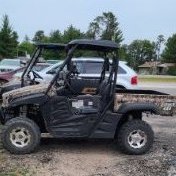By
AlphaSerenity
Hello,
Before I invest $10k+ into a brand new UTV for the farm, I want to get my feet wet with a fixer upper and learn the mechanical side of things. I acquired a 2022 Hisun Axis 500 (Lowes-specific model) from an auction for $500. It has only 200 hours and 120 miles on the engine. It looks like the previous owner used it for ranch work and didn't drive it on trails, deep water/mud, or anything too crazy.
While it runs and moves, it has some problems. It struggles to accelerate up any incline in high and low range and sometimes stalls when I let off of the throttle or change gears. When I apply throttle in neutral, it sounds like it is struggling for fuel/air and pops. When I decelerate, there is a grinding sound coming from the clutch, which I've read to be related to the one way bearing and is semi-common. The last thing I've observed is sometimes the speedometer display sometimes will show a much higher value for a few seconds after barely touching the throttle. Based on the documentation, if a problem is detected from the sensors, the instrument panel display should have an error code rendered on the screen in place of the time, but this isn't happening. Here is a video showing some of these issues (engine is exposed with console removed):
https://www.youtube.com/watch?v=FFAkO5TaGps
Here is another video of the clutches in action:
I've done some research, but information on this specific unit and sister units is limited. There does seem to be transmission and clutch issues reported. I still need to check into the head gaskets. I don't have the equipment to test compression right now, but I do plan on ordering what is needed soon. I do have an order in place for some cables to read the diagnostics from the computer. There is a shop two hours away from me that works on Hisun products, but I am hoping the problem can be identified and is something within my ability to handle. Below is what I've already investigated. I am leaning towards the primary clutch needing replacement right now.
After getting it home and unloaded, I did the following maintenance/checks to it prior to operating it further:
Changed the engine/clutch oil (and filter) and gear oils using manufacture recommended viscosity
Changed the air filter and checked for cracks in the air intake flow. Verified good suction.
Cleaned the throttle body
Changed the spark plug and verified the gap was within spec (0.6-0.7mm)
Changed the coil and coil wire
Changed the fuel lines, fuel injector, and verified the fuel pump was outputting the correct initial prime pressure for ignition and continuous pressure after ignition. Also completely emptied the fuel tank and made sure octane 91+ fuel is being used per manufacturer specs. Ran seafoam through system too.
Cleaned the spark arrester and verified no cracks or gaps in the exhaust flow
Changed out the O2 sensor
Checked all wired connections to ensure they were secured and no breaks were visible
Checked the belt for tightness and for any signs of wear and tear
Verified 4WD and the differential lock function as expected - still hesitates and struggles uphill
Verified the fan gears in the shifter are not corroded and working as expected
ECU was reset after replacing sensors and fuel-related parts
Thanks!





Recommended Posts
Join the conversation
You can post now and register later. If you have an account, sign in now to post with your account.
Note: Your post will require moderator approval before it will be visible.